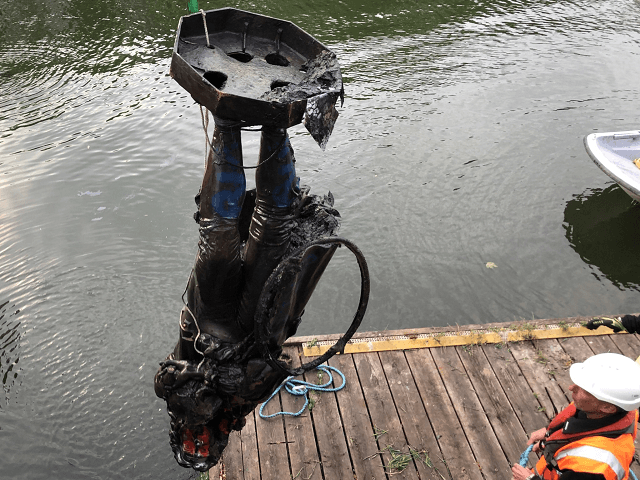The statue of 17th-century Bristol philanthropist Edward Colston, which was torn down from its plinth, vandalised, and thrown into the harbour by an angry mob of Black Lives Matter protesters in June 2020 over his links to slavery, will be put in a museum alongside paraphernalia linked to the Marxist protest movement.
The statue was erected in the port city of Bristol in 1895 to commemorate the philanthropy of Colston, who died in 1721. The successful merchant and Member of Parliament had financially supported almshouses, hospitals, and schools and paid for the upkeep and repairs to Bristol cathedral and seven local churches.
But Colston appears to now only be known for his links to the Atlantic slave trade and is currently undergoing an unpersoning throughout the woke city, with his name and family crest being removed from schools, buildings, and other public spaces — even a stained glass window dedicated to Colston was removed from the cathedral that he had financially supported.
Days after the Victorian bronze statue was thrown into the water, Bristol City Council retrieved it and pledged not to restore it but to put it in a museum, with Bristol Museums announcing on Friday it would go on display at M Shed, which focuses on the history of the city.
The statue is on display alongside BLM placards from the protest as well as an old bicycle tyre that was picked up with it — suggesting that the statue, and thus the man who it represented and his place in Bristol’s history, was likewise simply another piece of garbage retrieved from the woke city’s murky waters.
The Guardian reported that after the statue was pulled out of the harbour, M Shed’s conservation team cleaned the statue — but “stabilised” the graffiti to stop it from flaking off.
M Shed’s conservationist Fran Coles said: “The aim of our conservation work was to stabilise the statue and prevent deterioration from the water and silt it had been exposed to.
“This will prepare the statue for whatever its future may be. M Shed’s role is to reflect the history and contemporary issues relating to Bristol, telling the stories that matter to the people of Bristol.
“Therefore, it is a very suitable location for this short-term display of the statue. It will enable visitors to take stock and make their own minds up concerning the future of the statue. The display and survey will also be online, helping to reach people across the city and beyond.”
Campaign group Save Our Statues condemned presenting the memorial whilst still covered in spray paint, saying: “It’s wrong to hold Colston up to ridicule by leaving the graffiti. Whatever its future, it must be restored and we must not celebrate the mob.”
The fate of the statue is not settled as the display is only temporary, with Bristol Museums stating on Friday that its placement was intended to “start a city-wide conversation about its future”.
The museum then invites visitors to complete a survey “to hear your thoughts on what happened that day and what you think should happen next. This is an opportunity to have your say on how we move forward together.”
“Your feedback will help the History Commission make a recommendation on the future of the Colston statue,” it added.
Bristol mayor Marvin Rees, who called the lawless vandalism a “piece of historical poetry”, said: “The future of the statue must be decided by the people of Bristol and so I urge everyone to take the opportunity to share their views and help inform future decisions by taking part in the survey.”
Since the events in Bristol and other acts of iconoclasm across the country, the government had passed a law meaning that the removal of memorials must go through official processes, with the Johnson administration favouring the “retain and explain” method of keeping statues, providing so-called context when there are alleged controversies.
On Thursday, the Save Our Statues campaign group made the observation that the “retain and explain” system plays into the hands of far-leftists, who want to “cover” the country’s monuments “in plaques and transform them into anti-British propaganda. This was always the aim.”
Follow Breitbart London on Facebook: Breitbart London

COMMENTS
Please let us know if you're having issues with commenting.